DIY EMF Measurements process and technics. measuring where people are, scanning the room, find sources and penetration points, safety distances, and more…
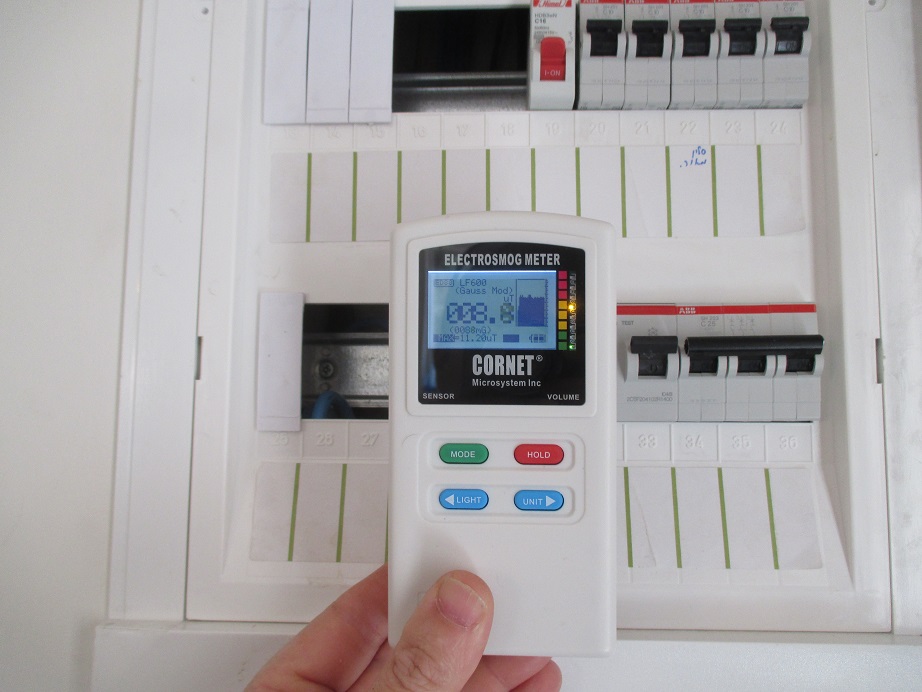
Please also read the following page as background – https://www.norad4u.com/measure/diy-emf-measurements-the-basics/
Several ways to measure electromagnetic radiation
It is important to know the difference between the different types of Electromagnetic Radiation (EMF/EMR) measurements. Every type of measurement will have a different focus, different methods, and in some cases, you should use different meters. The right meter should be chosen according to its characteristics and not only according to the frequency that it can measure.
Which level is safe?
For RF, we consider levels higher than 0.04mW/m2 too high for none-EHS people( for EHS it sho pore pore uld be closed to 0.0005mW/m2).
For ELF Magnetic field, we consider everything higher than 2mG to be problematic.
For ELF Electric Field, we consider everything higher to 10V/m to be a problem.
Please press here to read more about ICRNIP’s, WHO, countries and our recommendations for reasonable RF and ELF exposure levels..
Measure where people are
The most simple way to measure the EMF / EMR radiation is to measure it where people usually stay for a long time like:
- The sleeping bed
- Working desk/station
- Sofas/couch
- Kid’s playing room
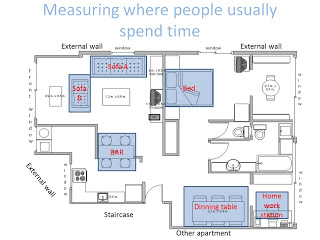
The technique is to measure on top and next to the place in which the human body will be in most of the time, and to try and understand what will be the radiation level, and for how long the body will be exposed to it. In addition, you need to try and figure out which radiation sources influence the radiation levels at this point.
Debugging
So when you see a high level of EMF, try turning OFF, or cutting the power to the electric and electronic devices around you, until the levels drop. The device that turning it OFF gets the levels down, and turning it back ON get them up again, is the one causing the high EMF levels. If all the devices are OFF or plugged out of the power socket and the EMF levels are still high, try turning OFF the main brackets in the power cabinet.
If there is a problem, fix it, even if the exposure is low or short
In the past, I came across people who told me that they found a radiation source on their home working station desk, but they didn’t think that it was serious since they sit next to it only for a short time. When I asked them for “how short?”, they replied that they use it for half an hour to one hour each day. I just want to make it clear; I think that every exposure to electromagnetic radiation is not good and should be minimized as much as possible, and if possible to reduce it down to zero. Half an hour a day is not a short time as much as exposure to radiation is concerned, it is a lot of time. Whenever there is radiation exposure it is highly recommended to try to find the source and turn it off(or move it away) so there will be no radiation emission.

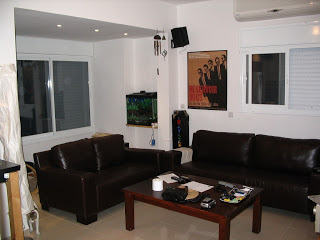
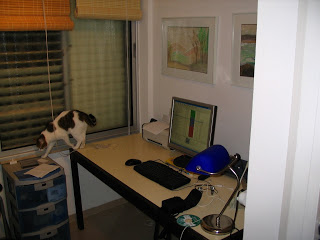
Scan the room for sources and penetration points.
Scan the room for sources, and scan the walls, ceiling, floor, and windows for penetration points.
Searching for radiation sources in a room:
Most types of electromagnetic radiation meters, even the simplest ones, can be used for searching radiation sources in a room (the meter should be for the same type of electromagnetic radiation as the source emits, either high frequency-RF or low frequency). All you have to do is to scan the room step by step, meter by meter. Whenever the meter shows an increase in the radiation levels that means that you are getting closer to a source. If the radiation levels are dropping you are getting away from the source. It is recommended to use a meter with a voice indication that makes it easier to notice changes in the radiation levels without looking at the meter’s display.
Scan key points:
- Scan in the room 3 times, once on the floor, a second time at 1-1.5 meters high, and then at the height of a human being’s head or a bit higher.
- The scan should include all the parts of the room.
- Use a clear and constant scanning pattern, e.g from one side of the room to the other side, more one meter aside and then back.
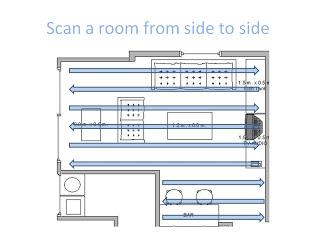
Searching for radiation sources from other rooms or outside the house
When searching for radiation sources outside the room we should focus on the border areas of the room with other spaces of the house (other rooms and floors) and with the outside, like walls, windows, doors, rooftops, and underground spaces.
When there is a high-level radiation source outside the room, the first sign for that will be medium to high radiation background levels inside the room itself.
When getting close to a penetration point of RF or ELF on the walls or windows, the levels should go higher in reference to the levels in the middle of the room.
Windows, dray-walls, some of the wood made walls, will usually pass most RF. In ELF magnetic field the radiation will pass through most building materials, both windows and walls.
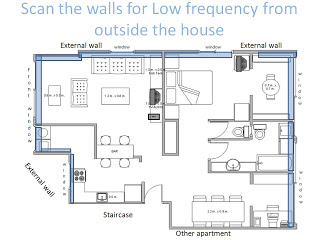
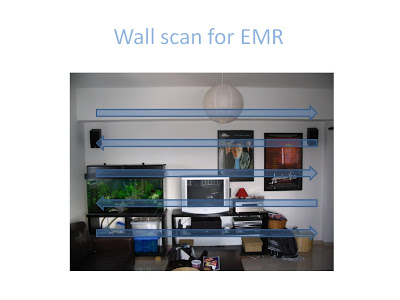
Examples:
- When there is a high current electric wire inside the wall, the low frequency that is created around the wire will penetrate the room. If you scan the wall, vertically and horizontally with a Low-frequency electromagnetic meter, the meter will show high radiation levels near the wire and will enable you to expose the wire as the radiation source.
- In case there is a DECT base station next to the wall in the next room, the first signs will be medium to high levels of high-frequency radiation inside the room. When the wall between the DECT phone and the room will be scanned, the radiation levels will increase as the meter will be closer to the DECT phone location. You should scan that wall until the meter will reach the maximum measurement. This is where the DECT phone is on the other side of the wall.
- In some cases when there is a radiation source on the next floor, or on the floor below, the highest levels will be measured on the ceiling or floor between the meter and the source located on the other floor.
- When there is a high-frequency radiation source outside the house, for example, a mobile phone mast, the meter will show high levels of high-frequency electromagnetic radiation mostly next to the windows, and in some cases even on the wall which is in the direction of the mobile phone mast(depending on the building material of the wall).
- When there is a low-frequency radiation source in the near vicinity of the house (like an external electric power converter or high voltage electric power line) you will be able to measure high levels of extreme low frequency magnetic field radiation in parts of the rooms of the house which are closest to it (low-frequency electromagnetic radiation passes easily via walls but fade off in short distance).
- When there is a CRT TV on the other side of a wall you will be able to measure high levels of low-frequency electromagnetic radiation in the room, the pick will be on the wall next to the location of the TV (on the other side).
- When there is an external radiation source outside the room that radiates in medium or low levels, for example, a WiFi router or a small power converter it will be difficult to locate the source by doing measurements in the room next door. In order to do so, you will need to use a very sensitive and accurate advanced electromagnetic meter with a detailed display and directional antenna. In this case, it is recommended taking a look inside the rooms next door in order to get some clues for the radiation source that can influence the measurement.

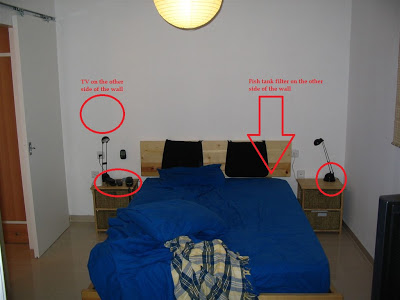
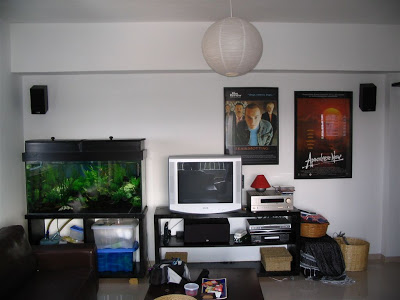
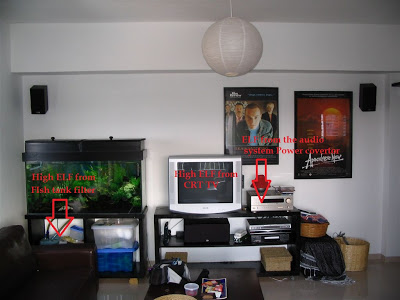
Identify radiation sources outside the house.
RF Out in the open
In order to identify high-frequency radiation sources outside the house, you need to use a directional radiation meter (the meter should have a directional antenna). The trick is to hold the meter in front of you and to scan the 360 degrees around you (turn yourself around). When the meter will be directing to or will be closer to a radiation source, the radiation levels will usually be higher than when the source is not in front of the meter with your torso in between) or far away from it.
If you are using a 3 axis meter it is best to configure the meter to measure only in the axis which is parallel to the axis of the radiation source (for example axis Y for mobile phone masts).
In house RF – Scan the opening and windows
Identifying EMF sources and penetration points to your house or office from outside the house (Neighbors, Cell phone mast/towers, power lines …) should be done by scanning the walls and opening(windows and doors) of the house(including internal walls). If you or your neighbor put an EMF source to the wall, you should be able to see higher levels of radiation as you get closer to the penetration point while you scan the wall. Even if you can’t actually see the source, the radiation penetration points should be visible.
In RF radiation from cell phone towers (or other outdoor communication infrastructure), in most cases, most of the RF radiation will penetrate the house through the windows. Therefore you should give priority to scanning the windows first while searching for RF penetration points. When finding a window with the RF coming in from it, Document also the levels on the wall aside it. This will help in choosing the right protection and to decide whether to use protection over the walls as well as the windows.
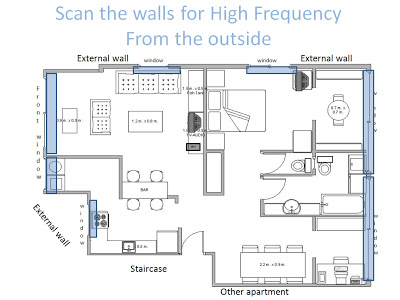
ELF Magnetic sources
Identifying low-frequency radiation sources outside the house is trickier since low-frequency electromagnetic radiation is less directional than the high frequency. The search for the source should be based on getting closer or going away from the radiation source while trying to look around and guess where the low-frequency radiation sources are located in the near vicinity.
Even when you are inside the house, since the walls do not stop ELF magnetic field, you can’t count on more ELF magnetic fields to pass via the wall, for any clues. Try to scan the house and find a connection between when the levels were high, and the surrounding electric appliances and infrastructures in and outside the house.
Measuring Safety distances
Safety distances form RF sources
In my humble opinion, as far as RF radiation is concerned, there is no safe distance from an RF source. Home use RF equipment reaches working distances of 50 meters and more inside the house, and even greater distances outside the house. Even 5 meters from a WIFI router, a fast RF meter will still show levels of RF that we believe are too high for chronic exposure. Since we think there is no healthy level of RF radiation, and since we understand that as long there is “reception” we have radiation, then as soon as you put a wireless devices in the house, there could not be a safety distances from it, even if the RF meter show low levels from it, as long there is reception, there is radiation.
However, It should be cleared that as you move away from the RF source, the levels will be lower, and your exposure will reduce, but I don’t believe it is reasonable to say or determinate safety distance from wireless equipment, especially when it is broadcasting 24X7. For example, putting a WIFI router 5 meters away from people is less of a problem than putting it 1 meter away from people, while not using the wireless option of the router (turning the WIFI OFF and connecting the PCs and TVs using net cables) is the best option.
Safety distances from ELF sources
As far as ELF Magnetic fields go, finding the safety distance is relatively easy. 0.5 -2 meters should be enough distance in most cases of in-house ELF magnetic sources. If you are using a single Axis ELF magnetic field meter, you should first measure in the same point in space, in all 3 axis to find the axis with the highest reading. In a 3 Axis EMF magnetic field meter, it is enough to find a spot next to the source that allows you easy measurement. Then start to move away from the source and watch the levels go down. As soon as the level goes down from 2 mG(or a level you consider safe), it should be considered OK to pass or stay in this spot for a while. Continue to move away from the source and watch the levels drop until the level reaches the background level, or/and the source stop influencing the meter. You can then add 50cm (just to be sure) to reach full safety distance.
- Find the point and axis with the highest levels next to the source.
- Move back until the levels drop to an acceptable threshold.
- Add 0.5 meter to be on the safe side.
- This is your safety distance.
